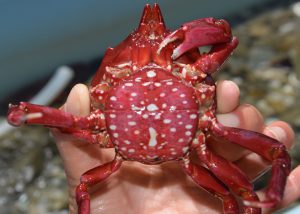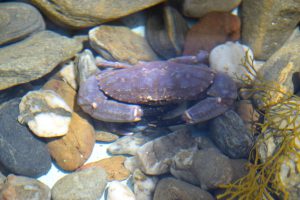
Crabs are members of the phylum Arthropoda, which means jointed appendages. Anyone who has picked up a crab, only to have it reach behind and pinch them, knows this is true! Crabs have a thick exoskeleton, or skeleton on the outside of their bodies. Since they are invertebrates, this allows them to have a rigid body shape without a spine. Because of this, when crabs grow they must molt, or shed, their exoskeleton and grow a new one. Most crabs also have a single pair of claws, also called chelae.
It is actually very easy to tell the difference between a male and female crab. On the underside of the carapace, or body, of a crab there is a shape. In male crabs, this shape is a thin triangle. In females, the bottom of the carapace has a large semicircle. Females need this extra space to hold fertilized eggs underneath this flap.


Crabs are omnivores, feeding on algae and other organic material on rocks or the sea floor. On Catalina Island, you can find crabs in a variety of habitats. When tidepooling in the intertidal zone you can often find a Striped Shore crab. While snorkeling near the rocky reef, you might find a Dungeness crab wedged into the rocks. Snorkeling over the sandy bottom in the spring often yields a large Sheep crab.
Striped Shore crabs (Pachygrapsus crassipes) have a dark carapace with thin black and dark green stripes running horizontally. Across the back, they average 3 inches across. Their claws are usually a bright red or pink coloration, and their other appendages are striped or black. They live high in the intertidal zone and spend at least half their time out of water. They must return periodically, however, to wet their gills. They primarily feed by scraping algae off of rocks, but occasionally eat other invertebrates. Their predators include birds and two-spot octopus.

Dungeness crabs are also commonly called Cancer crabs because of their scientific name, Cancer magister. They are common throughout California. They can grow up to 9 inches across, with males averaging 7 inches across the back, and females averaging around 6 inches, making them one of the largest edible Pacific coast crabs. Their backs range from light reddish to purple, and their claws are usually black.

Sheep crabs are the largest California spider crabs (Majidae). They have long legs and an oval shaped body. The carapace is covered in bumps and, usually, algae and barnacles. Juvenile sheep crabs decorate themselves with algae, barnacles and bryozoans to camouflage themselves. Adults usually have enough built up on their carapace to stop decorating themselves. Sheep crabs spend the winter in deep water, migrating to shallow water in the early spring to mate. While some crab species can molt their entire lives, sheep crabs have a terminal molt. This means that at a certain age, sheep crabs are unable to increase in size or regenerate lost limbs. Males can get up to 10 inches across the back, females to 7 inches. They are scavengers that feed on almost anything.


